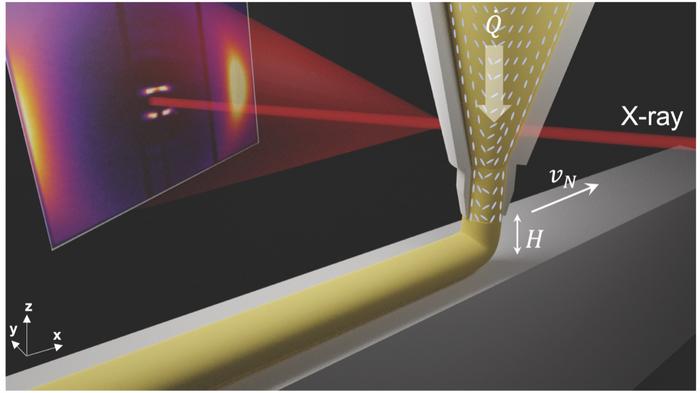
In recent advancements within the realm of soft materials, researchers have made significant strides in the 3D printing of liquid crystal elastomers (LCEs), which are synthetic materials engineered to change shape in response to temperature variations. Much like biological muscles that respond to nervous stimuli, LCEs exhibit remarkable shape-morphing capabilities. This innovative research not only enriches the scope of applications for LCEs but also unlocks potential developments in fields as diverse as soft robotics, adaptive structures, prosthetics, and even smart textiles.
At the core of this research is a novel approach to controlling the internal alignment of LCEs during the 3D printing process. Liquid crystal elastomers consist of molecular chains that include rigid building blocks known as mesogens. These mesogens can be aligned at the molecular scale, which significantly influences the macroscopic properties of the material. Achieving the right degree of alignment has historically involved a cumbersome process of trial and error, influencing the ability of researchers to manipulate material properties effectively and predictably.
The collaborative study led by researchers from prestigious institutions such as the Harvard John A. Paulson School of Engineering and Applied Sciences, Princeton University, and Lawrence Livermore National Laboratory, has laid down a comprehensive framework to produce liquid crystal elastomers with consistent and controllable alignment. This approach utilizes X-ray microbeam technology to allow for real-time measurement of mesogen alignment during the printing process, presenting a new paradigm in material science research.
The significance of this study cannot be overstated. By examining factors such as nozzle design and printing conditions, researchers were able to fine-tune parameters to achieve desired alignment in the material. The findings indicate that by adjusting parameters like nozzle shape, speed of ink extrusion, and temperature, teams could induce specific molecular-scale alignments that translate into desired behaviors at the macroscopic level, essentially producing tailored materials for specialized applications.
One of the transformative contributions of this work is the introduction of varying nozzle shapes to influence flow dynamics within the printing process. Tapered or hyperbolic nozzles, for instance, manipulate how the LCE ink exits the nozzle, directly affecting molecular orientation as the material is extruded. The researchers successfully demonstrated that altering the design not only improves the alignment of the mesogens but can also dramatically enhance the mechanical properties of the resulting printed structures.
The researchers employed wide-angle X-ray scattering measurements at specialized facilities to visualize the alignment of liquid crystal elastomers during the printing process. This in situ measurement capability provided unprecedented insights into how different fluid flow patterns and dye alignment interacted, allowing the team to refine their models of material behavior during the process of 3D printing. The ability to effectively see inside the printer itself offered critical data that can be crucial for future developments in both printing technology and material science.
Notably, the research revealed that the hyperbolic nozzle design produced a more uniform alignment of molecular chains compared to standard designs. This revelation has profound implications as it opens the door for creating LCE structures with optimized shape-morphing abilities, which could be harnessed for adaptive structures that can change shape and function according to varying environments or demands.
Moreover, the work conducted by the team signals a much-needed shift in the computational modeling of these complex materials. By integrating their empirical results into existing frameworks, the researchers proposed new methodologies for understanding flow-induced alignment in LCEs. Their findings provide invaluable data for the 3D printing community, which typically relies on a limited array of commercially available printheads and offers a clear call to action to explore the forgotten intricacies of nozzle geometry and flow to manipulate material responses innovatively.
The successful alignment of LCEs is crucial for their performance, as improved alignment correlates directly with the material’s actuation capabilities. The researchers found that when closely aligned, these liquid crystal chains exhibit significantly better responses to thermal stimuli, thus enhancing their applicability in soft robotics and adaptive systems. This work lays the groundwork not only for efficient material production but also for enhancing the intelligence and responsiveness of future soft actuators.
While soft robotics and responsive materials hold remarkable potential for various industries, the road to widespread adoption will necessitate continued refinement of printing techniques and materials development. This pioneering research underlines the importance of interdisciplinary collaboration between engineers, materials scientists, and physicists in endeavors aiming for the development of smart materials.
In conclusion, through their innovative research into the printing of liquid crystal elastomers, the team has not only advanced the field of 3D printing but has also set the stage for future explorations in responsive materials. Such initiatives promise to revolutionize not only the manufacturing sector but also significantly transform how adaptable technologies are conceived in medicine, robotics, and smart infrastructure. This research represents a significant leap toward harnessing the full potential of synthetic soft materials, bringing science fiction closer to reality.
Subject of Research: The alignment and actuation of printed liquid crystal elastomers.
Article Title: Spatially programmed alignment and actuation in printed liquid crystal elastomers.
News Publication Date: 15-Jan-2025.
Web References: DOI Link
References: n/a
Image Credits: Credit: Lewis Lab/Harvard John A. Paulson School of Engineering and Applied Sciences
Keywords
Tags: 3D printing liquid crystal elastomersadaptive structures in engineeringapplications of liquid crystal elastomerscollaborative research institutions in material innovationcontrolling molecular alignment in materialsinterdisciplinary research in materials sciencemesogen alignment in elastomersnovel approaches in material engineeringprosthetics innovation through 3D printingshape-morphing soft materialssmart textiles technologysoft robotics advancements





